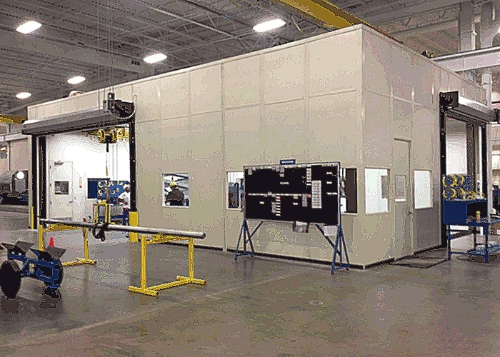

Acoustic Enclosure for Press Machine
Enhance workplace safety and comfort with high-quality acoustic enclosures for press machines. These enclosures effectively reduce noise levels, ensuring compliance with industrial noise regulations while maintaining optimal machine performance. Designed for durability and efficiency, they provide a quieter environment, boosting productivity and protecting worker health. Customizable to your needs.
Guru Kripa Engineering is a leading Acoustic Enclosure manufacturer in India. Soundproof Acoustic Enclosure, also referred to as a sound enclosure or soundproof enclosure, serves as a specialized structure aimed at mitigating or managing the transmission of sound. This architectural solution is commonly applied to isolate noisy equipment like air compressors, glass crusher machines, blowers, turbines, and DG sets, among others, from their immediate surroundings. Its purpose extends to creating a controlled acoustic environment for specific activities or processes.
Applications of Acoustic Enclosures:
Acoustic enclosures find widespread use in various industrial settings, including power plants, factories, and manufacturing facilities, where loud machinery or equipment generates substantial noise. Moreover, they are employed in environments such as recording studios, broadcast facilities, and theaters to establish a controlled acoustic setting for sound recording or performances. Additionally, acoustic enclosures can be utilized in residential or commercial buildings to minimize external noise sources like traffic or construction.
Design and Construction:
The design and construction of an acoustic enclosure are contingent on factors such as the desired level of noise reduction, the frequency range of the noise, and the specific requirements of the application. Considerations for proper ventilation and access points are integral to ensuring that the enclosed space remains functional while effectively controlling sound.
Functionality of Acoustic Enclosures:
Acoustic enclosures in India are engineered to employ sound-absorbing and sound-blocking techniques for effective sound control. The key operational aspects include:
Sound Absorption: The interior surfaces of the enclosure feature materials with high sound absorption properties, such as foam, mineral wool, or specialized acoustic panels. When sound waves enter the enclosure, these materials convert sound energy into heat through friction and internal reflection, reducing the sound’s intensity.
Sound Blocking: Walls, floors, and ceilings of the enclosure are constructed with dense and heavy materials like mass-loaded vinyl, composite panels, or thick glass to create barriers. These materials reflect and refract sound waves, preventing their transmission through the enclosure.
Sealing: Acoustic enclosures are meticulously sealed to minimize sound leakage, with gaps, joints, and access points sealed using acoustic caulking, gaskets, or weathers tripping.
Ventilation and Access Points: Proper ventilation and access points for equipment or personnel are maintained, with attention given to designing ventilation systems that allow airflow while minimizing sound transmission. Acoustic louvers or attenuators may be integrated into ventilation openings to reduce noise without compromising airflow. By employing these techniques.
An Acoustic Enclosure establishes a controlled acoustic environment. Sound-absorbing materials diminish sound intensity within the enclosure, while sound-blocking materials and effective sealing prevent sound from escaping or entering the enclosed space. This results in a quieter environment inside the enclosure, minimizing the impact of noise on the surrounding area.
